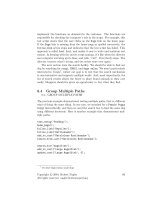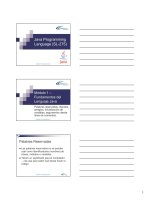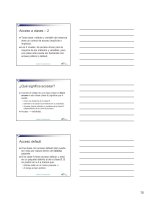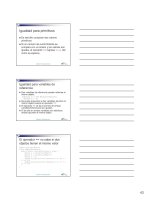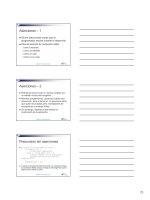java programming language basics phần 5 docx
Bạn đang xem bản rút gọn của tài liệu. Xem và tải ngay bản đầy đủ của tài liệu tại đây (349.26 KB, 14 trang )
This lesson converts the File Input and Output application from Lesson 6:
File Access and Permissions to the RMI API.
Program Behavior
The RMIClient1
program presents a simple user interface and prompts for
text input. When you click the Click Me button, the text is sent to the
RMIClient2
program by way of the remote server object. When you click
the Click Me button on the RMIClient2 program, the text sent from
RMIClient1 appears.
First Instance of Client 1
If you start a second instance of RMIClient1 and type in some text, that
text is sent to RMIClient2 when you click the Click Me button. To see
the text received by RMIClient2, click its Click Me button.
Second Instance of Client 1
File Summary
The example program consists of the RMIClient1 program, remote object
and interface, and the RMIClient2 program as illustrated in the diagram.
The corresponding source code files for these executables are described
in the bullet list below.
RMIClient1.java: Client program that calls the sendData method on
the RemoteServer server object.
RMIClient2.java: Client program that calls the getData method on
2 of 11 21-04-2000 17:32
Java(TM) Language Basics, Part 1, Lesson 8: Remote Method Invocation raining/Programming/BasicJava1/rmi.html
the
RemoteServer
server object.
RemoteServer.java: Remote server object that implements
Send.java and the sendData and getData remote methods.
Send.java: Remote interface that declares the sendData and
getData remote server methods.
In addition, the following java.policy
security policy file grants the
permissions needed to run the example.
grant {
permission java.net.SocketPermission
"*:1024-65535",
"connect,accept,resolve";
permission java.net.SocketPermission
"*:80", "connect";
permission java.awt.AWTPermission
"accessEventQueue";
permission java.awt.AWTPermission
"showWindowWithoutWarningBanner";
};
Compile the Example
These instructions assume development is in the zelda home directory.
The server program is compiled in the home directory for user zelda, but
copied to the public_html directory for user zelda where it runs.
Here is the command sequence for the Unix and Win32 platforms; an
explanation follows.
Unix:
cd /home/zelda/classes
javac Send.java
javac RemoteServer.java
javac RMIClient2.java
javac RMIClient1.java
rmic -d . RemoteServer
cp RemoteServer*.class /home/zelda/public_html/classes
cp Send.class /home/zelda/public_html/classes
Win32:
cd \home\zelda\classes
javac Send.java
javac RemoteServer.java
javac RMIClient2.java
javac RMIClient1.java
rmic -d . RemoteServer
copy RemoteServer*.class \home\zelda\public_html\classes
copy Send.class \home\zelda\public_html\classes
The first two javac commands compile the RemoteServer and Send
class and interface. The third javac command compiles the RMIClient2
class. The last javac command compiles the RMIClient1 class.
The next line runs the rmic command on the RemoteServer server
3 of 11 21-04-2000 17:32
Java(TM) Language Basics, Part 1, Lesson 8: Remote Method Invocation raining/Programming/BasicJava1/rmi.html
class. This command produces output class files of the form
ClassName_Stub.class and ClassName_Skel.class. These output
classes let clients invoke methods on the RemoteServer server object.
The first copy command moves the RemoteServer class file with its
associated skel and stub class files to a publicly accessible location in
the /home/zelda/public_html/classes directory, which is on the
server machine, so they can be publicly accessed and downloaded. They
are placed in the public_html directory to be under the web server
running on the server machine because these files are accessed by client
programs using URLs.
The second copy command moves the Send class file to the same location
for the same reason. The RMIClient1 and RMIClient2 class files are
not made publicly accessible; they communicate from their client machines
using URLs to access and download the remote object files in the
public_html directory.
RMIClient1 is invoked from a client-side directory and uses the
server-side web server and client-side Java VM to download the
publicly accessible files.
RMIClient2 is invoked from a client-side directory and uses the
server-side web server and client-side Java VM to download the
publicly accessible files.
Start the RMI Registry
Before you start the client programs, you must start the RMI Registry,
which is a server-side naming repository that allows remote clients to get a
reference to the remote server object.
Before you start the RMI Registry, make sure the shell or window in which
you run the rmiregistry command does not have a CLASSPATH
environment variable that points to the remote object classes, including the
stub and skel classes, anywhere on your system. If the RMI Registry
finds these classes when it starts, it will not load them from the server-side
4 of 11 21-04-2000 17:32
Java(TM) Language Basics, Part 1, Lesson 8: Remote Method Invocation raining/Programming/BasicJava1/rmi.html
Java VM, which will create problems when clients try to download the
remote server classes.
The following commands unset the CLASSPATH and start the RMI Registry
on the default 1099 port. You can specify a different port by adding the
port number as follows: rmiregistry 4444 &. If you specify a different
port number, you must specify the same port number in your server-side
code as well.
Unix:
cd /home/zelda/public_html/classes
unsetenv CLASSPATH
rmiregistry &
Win32:
cd \home\zelda\public_html\classes
set CLASSPATH=
start rmiregistry
Note: You might want to set the CLASSPATH back to its original
setting at this point.
Run the RemoteServer Server Object
To run the example programs, start RemoteServer first. If you start
either RMIClient1 or RMIClient2 first, they will not be able to establish
a connection because the remote server object is not running.
In this example, RemoteServer is started from the
/home/zelda/public_html/classes directory.
The lines beginning at java should be all on one line with spaces where
the lines break. The properties specified with the -D option to the java
interpreter command are program attributes that manage the behavior of
the program for this invocation.
Unix:
cd /home/zelda/public_html/classes
java
-Djava.rmi.server.codebase=http://kq6py/~zelda/classes
-Djava.rmi.server.hostname=kq6py.eng.sun.com
-Djava.security.policy=java.policy RemoteServer
Win32:
cd \home\zelda\public_html\classes
java -Djava.rmi.server.codebase=file:
c:\home\zelda\public_html\classes
-Djava.rmi.server.hostname=kq6py.eng.sun.com
-Djava.security.policy=java.policy RemoteServer
The java.rmi.server.codebase property specifies where the
publicly accessible classes are located.
The java.rmi.server.hostname property is the complete host
5 of 11 21-04-2000 17:32
Java(TM) Language Basics, Part 1, Lesson 8: Remote Method Invocation raining/Programming/BasicJava1/rmi.html
name of the server where the publicly accessible classes reside.
The
java.rmi.security.policy
property specifies the policy file
with the permissions needed to run the remote server object and
access the remote server classes for download.
The class to execute (RemoteServer).
Run the RMIClient1 Program
Here is the command sequence for the Unix and Win32 platforms; an
explanation follows.
In this example, RMIClient1 is started from the
/home/zelda/classes directory.
The lines beginning at java should be all on one line with spaces where
the lines break. Properties specified with the -D option to the java
interpreter command are program attributes that manage the behavior of
the program for this invocation.
Unix:
cd /home/zelda/classes
java -Djava.rmi.server.codebase=
http://kq6py/~zelda/classes/
-Djava.security.policy=java.policy
RMIClient1 kq6py.eng.sun.com
Win32:
cd \home\zelda\classes
java -Djava.rmi.server.codebase=
file:c:\home\zelda\classes\
-Djava.security.policy=java.policy
RMIClient1 kq6py.eng.sun.com
The java.rmi.server.codebase property specifies where the
publicly accessible classes for downloading are located.
The java.security.policy property specifies the policy file with
the permissions needed to run the client program and access the
remote server classes.
The client program class to execute (RMIClient1), and the host
name of the server (Kq6py) where the remote server classes are.
Run RMIClient2
Here is the command sequence for the Unix and Win32 platforms; an
explanation follows.
In this example, RMIClient2 is started from the
/home/zelda/classes directory.
6 of 11 21-04-2000 17:32
Java(TM) Language Basics, Part 1, Lesson 8: Remote Method Invocation raining/Programming/BasicJava1/rmi.html
The lines beginning at
java
should be all on one line with spaces where
the lines break. The properties specified with the -D option to the java
interpreter command are program attributes that manage the behavior of
the program for this invocation.
Unix:
cd /home/zelda/classes
java -Djava.rmi.server.codebase=
http://kq6py/~zelda/classes
-Djava.security.policy=java.policy
RMIClient2 kq6py.eng.sun.com
Win32:
cd \home\zelda\classes
java -Djava.rmi.server.codebase=
file:c:\home\zelda\public_html\classes
-Djava.security.policy=java.policy
RMIClient2 kq6py.eng.sun.com
The java.rmi.server.codebase property specifies where the
publicly accessible classes are located.
The java.rmi.server.hostname property is the complete host
name of the server where the publicly accessible classes reside.
The java.rmi.security.policy property specifies the policy file
with the permissions needed to run the remote server object and
access the remote server classes for download.
The class to execute (RMIClient2).
RemoteServer Class
The RemoteServer class extends UnicastRemoteObject and
implements the sendData and getData methods declared in the Send
interface. These are the remotely accessible methods.
UnicastRemoteObject implements a number of java.lang.Object
methods for remote objects and includes constructors and static methods
to make a remote object available to receive method calls from client
programs.
class RemoteServer extends UnicastRemoteObject
implements Send {
String text;
public RemoteServer() throws RemoteException {
super();
}
public void sendData(String gotText){
text = gotText;
}
public String getData(){
7 of 11 21-04-2000 17:32
Java(TM) Language Basics, Part 1, Lesson 8: Remote Method Invocation raining/Programming/BasicJava1/rmi.html
return text;
}
The main method installs the RMISecurityManager and opens a
connection with a port on the machine where the server program runs. The
security manager determines whether there is a policy file that lets
downloaded code perform tasks that require permissions. The main
method creates a name for the the RemoteServer object that includes
the server name (kq6py) where the RMI Registry and remote object run,
and the name, Send.
By default the server name uses port 1099. If you want to use a different
port number, you can add it with a colon as follows: kq6py:4444. If you
change the port here, you must start the RMI Registry
with the same port
number.
The try block creates an instance of the RemoteServer class and binds
the name to the remote object to the RMI Registry with the
Naming.rebind(name, remoteServer); statement.
public static void main(String[] args){
if(System.getSecurityManager() == null) {
System.setSecurityManager(new
RMISecurityManager());
}
String name = "//kq6py.eng.sun.com/Send";
try {
Send remoteServer = new RemoteServer();
Naming.rebind(name, remoteServer);
System.out.println("RemoteServer bound");
} catch (java.rmi.RemoteException e) {
System.out.println("Cannot create
remote server object");
} catch (java.net.MalformedURLException e) {
System.out.println("Cannot look up
server object");
}
}
}
Note: The remoteServer object is type Send (see instance
declaration at top of class) because the interface available to
clients is the Send interface and its methods; not the
RemoteServer class and its methods.
Send Interface
The Send
interface declares the methods implemented in the
RemoteServer class. These are the remotely accessible methods.
public interface Send extends Remote {
public void sendData(String text)
throws RemoteException;
8 of 11 21-04-2000 17:32
Java(TM) Language Basics, Part 1, Lesson 8: Remote Method Invocation raining/Programming/BasicJava1/rmi.html
public String getData() throws RemoteException;
}
RMIClient1 Class
The RMIClient1
class establishes a connection to the remote server
program and sends data to the remote server object. The code to do
these things is in the
actionPerformed
and
main
methods.
actionPerformed Method
The actionPerformed method calls the RemoteServer.sendData
method to send text to the remote server object.
public void actionPerformed(ActionEvent event){
Object source = event.getSource();
if(source == button){
//Send data over socket
String text = textField.getText();
try{
send.sendData(text);
} catch (java.rmi.RemoteException e) {
System.out.println("Cannot send data to server");
}
textField.setText(new String(""));
}
}
main Method
The main method installs the RMISecurityManager and creates a
name to use to look up the RemoteServer server object. The client uses
the Naming.lookup method to look up the RemoteServer object in the
RMI Registry running on the server.
The security manager determines whether there is a policy file that lets
downloaded code perform tasks that require permissions.
RMIClient1 frame = new RMIClient1();
if(System.getSecurityManager() == null) {
System.setSecurityManager(new RMISecurityManager());
}
try {
//args[0] contains name of server where Send runs
String name = "//" + args[0] + "/Send";
send = ((Send) Naming.lookup(name));
} catch (java.rmi.NotBoundException e) {
System.out.println("Cannot look up
remote server object");
} catch(java.rmi.RemoteException e){
System.out.println("Cannot look up
remote server object");
} catch(java.net.MalformedURLException e) {
System.out.println("Cannot look up
9 of 11 21-04-2000 17:32
Java(TM) Language Basics, Part 1, Lesson 8: Remote Method Invocation raining/Programming/BasicJava1/rmi.html
remote server object");
}
RMIClient2 Class
The RMIClient2
class establishes a connection with the remote server
program and gets the data from the remote server object and displays it.
The code to do this is in the
actionPerformed
and
main
methods.
actionPerformed Method
The actionPerformed method calls the RemoteServer.getData
method to retrieve the data sent by the client program. This data is
appended to the TextArea object for display to the end user on the
server side.
public void actionPerformed(ActionEvent event) {
Object source = event.getSource();
if(source == button){
try{
String text = send.getData();
textArea.append(text);
} catch (java.rmi.RemoteException e) {
System.out.println("Cannot send data
to server");
}
}
}
}
main Method
The main method installs the RMISecurityManager and creates a
name to use to look up the RemoteServer server object. The args[0]
parameter provides the name of the server host. The client uses the
Naming.lookup method to look up the RemoteServer object in the
RMI Registry running on the server.
The security manager determines whether there is a policy file that lets
downloaded code perform tasks that require permissions.
RMIClient2 frame = new RMIClient2();
if(System.getSecurityManager() == null) {
System.setSecurityManager(new RMISecurityManager());
}
try {
String name = "//" + args[0] + "/Send";
send = ((Send) Naming.lookup(name));
} catch (java.rmi.NotBoundException e) {
System.out.println("Cannot look up remote
server object");
} catch(java.rmi.RemoteException e){
System.out.println("Cannot look up remote
server object");
10 of 11 21-04-2000 17:32
Java(TM) Language Basics, Part 1, Lesson 8: Remote Method Invocation raining/Programming/BasicJava1/rmi.html
} catch(java.net.MalformedURLException e) {
System.out.println("Cannot look up remote
server object");
}
More Information
You can find more information on the RMI API in the RMI
trail of The Java
Tutorial.
[TOP]
[ This page was updated: 30-Mar-2000 ]
Products & APIs
| Developer Connection | Docs & Training | Online Support
Community Discussion | Industry News | Solutions Marketplace | Case Studies
Glossary
- Applets - Tutorial - Employment - Business & Licensing - Java Store - Java in the Real World
FAQ | Feedback | Map | A-Z Index
For more information on Java technology
and other software from Sun Microsystems, call:
(800) 786-7638
Outside the U.S. and Canada, dial your country's
AT&T Direct Access Number
first.
Copyright © 1995-2000 Sun Microsystems, Inc.
All Rights Reserved. Terms of Use. Privacy Policy.
11 of 11 21-04-2000 17:32
Java(TM) Language Basics, Part 1, Lesson 8: Remote Method Invocation raining/Programming/BasicJava1/rmi.html
Essentials of the Java
TM
Programming
Language: A Hands-On Guide, Part 2
by Monica Pawlan
[CONTENTS] [
NEXT>>
This series of lessons builds on the material presented in Java
TM
Programming Language Basics, Part 1, which introduced applications,
applets, and servlets; simple file and database access operations; and
remote method invocation (RMI).
The lessons and code examples for Part 2 are somewhat more complex.
They walk you through network communications, building a user interface
using more components, data encryption and decryption (pseudo code only),
grouping multiple data elements into one object (collections), and
internationalizing a program. Part 2 concludes with some object-oriented
programming concepts.
Contents
Lesson 1: Socket Communications
What are Sockets and Threads?
About the Examples
Example 1: Server-Side Program
Example 1: Client-Side Program
Example 2: Multithreaded Server Example
More Information
Lesson 2: User Interfaces Revisited
About the Example
Fruit Order Client Code
Global Variables
Constructor
Event Handling
Cursor Focus
Converting Strings to Numbers and Back
Server Program Code
View Order Client Code
Program Improvements
More Information
Lesson 3: Cryptography
About the Example
1 of 3 21-04-2000 17:33
Essentials of the Java(TM) Programming Language, Part 2 ining/Programming/BasicJava2/index.html
Running the Example
Pseudo Code
More Information
Lesson 4: Serialization
About the Example
Wrapping the Data
Sending Data
Server Program
Receiving Data
More Information
Lesson 5: Collections
About Collections
Creating a Set
Printing
More Information
Lesson 6: Internationalization
Identify Culturally Dependent Data
Create Keyword and Value Pair Files
Internationalize Application Text
Localize Numbers
Compile and Run the Application
Program Improvements
More Information
Lesson 7: Packages and Java Archive File Format
Setting up Class Packages
Create the Directories
Declare the Packages
Make Classes and Fields Accessible
Change Client Code to Find the Properties File
Compile and Run the Example
Using JAR Files to Deploy
Server Set of Files
Fruit Order Client Set of Files
View Order Client Set of Files
More Information
Lesson 8: Object-Oriented Programming
Object-Oriented Programming Defined
Classes
Objects
Well-Defined Boundaries and Cooperation
Inheritance
Polymorphism
Data Access Levels
2 of 3 21-04-2000 17:33
Essentials of the Java(TM) Programming Language, Part 2 ining/Programming/BasicJava2/index.html
Your Own Classes
Program Improvements
More Information
In Closing
Reader Feedback
Tell us what you think of this training book and earn two DukeDollars.
Very worth reading Worth reading Not worth reading
If you have other comments or ideas for future training books, please
type them here:
[
TOP
[ This page was updated: 6-Apr-2000 ]
Products & APIs | Developer Connection | Docs & Training | Online Support
Community Discussion | Industry News | Solutions Marketplace | Case Studies
Glossary - Applets - Tutorial - Employment - Business & Licensing - Java Store - Java in the Real World
FAQ
| Feedback | Map | A-Z Index
For more information on Java technology
and other software from Sun Microsystems, call:
(800) 786-7638
Outside the U.S. and Canada, dial your country's
AT&T Direct Access Number
first.
Copyright © 1995-2000 Sun Microsystems, Inc.
All Rights Reserved. Terms of Use. Privacy Policy.
Submit Reset
3 of 3 21-04-2000 17:33
Essentials of the Java(TM) Programming Language, Part 2 ining/Programming/BasicJava2/index.html
Java
TM
Programming Language Basics, Part 2
Lesson 1: Socket Communications
[<<BACK
] [CONTENTS] [NEXT>>]
Java
TM
Programming Language Basics, Part 1, finished with a simple
network communications example using the Remote Method Invocation
(RMI) application programming interface (API). The RMI example allows
multiple client programs to communicate with the same server program
without any explicit code to do this because the RMI API is built on sockets
and threads.
This lesson presents a simple sockets-based program to introduce the
concepts of sockets and multi-threaded programming. A multi-threaded
program performs multiple tasks at one time such as fielding simultaneous
requests from many client programs.
What are Sockets and Threads?
About the Examples
Example 1: Server-Side Program
Example 1: Client-Side Program
Example 2: Multithreaded Server Example
More Information
What are Sockets and Threads?
A socket is a software endpoint that establishes bidirectional
communication between a server program and one or more client
programs. The socket associates the server program with a specific
hardware port on the machine where it runs so any client program
anywhere in the network with a socket associated with that same port can
communicate with the server program.
A server program typically provides resources to
a network of client programs. Client programs
send requests to the server program, and the
server program responds to the request.
One way to handle requests from more than one
client is to make the server program
multi-threaded. A multi-threaded server creates a thread for each
communication it accepts from a client. A thread is a sequence of
instructions that run independently of the program and of any other
threads.
Using threads, a multi-threaded server program can accept a connection
1 of 8 21-04-2000 17:33
Java (TM) Language Basics, Part 2, Lesson 1: Socket Communications ning/Programming/BasicJava2/socket.html



